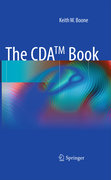
The CDA book provides clear and easy to use guidance to implement the standard, with numerous examples covering many of the nuances of the standard. Readers can learn not only how to implement healthcare IT using the CDA standard, but to 'speak' in the language of the standard, and to understand its idioms. Each chapter will include an overview, the main content, a summary of whatwas covered study and research questions at the back of the text to help the student discover the reasons why things are the way they are in the standard. Written by one of the leading developers of CDA implementation guides and a teacher of CDA to healthcare information professionals around the world. Internationally relevant to Healthcare IT professionals who are either presently using or want to use the CDA standard. INDICE: Introduction. Acknowledgements. Acronyms and Abbreviations.-Preface. Organization of this Book. Section I: Introduction. Section II: Data Types.Section III: CDA Modeling. Section IV: Implementing CDA. 1. Clinical Documentation. 1.1 Properties of Clinical Documents. 1.2 The 6 Characteristics of Clinical Documents. 2. The HL7 Clinical Document Architecture2.1 History of the Clinical Document Architecture. 2.2 CDA is based on XML. 2.3 Structure of a CDA Document. 2.4 Levels of CDA. Summary. 3. Extensible Markup Language. 3.1 The XML Declaration. 3.2 Namespaces. 3.3 XML Schema Language. 3.4 Parsing the CDA XML. Summary. 4 Basic Data Types. 4.1 ANY. 4.2 Booleans. 4.3 Quantities. Summary. 5 Text and Multimedia. 5.1 BIN Binary. 5.2 ED Encapsulated Data. 5.3 ST String. Summary. 6 Demographic Data. 6.1 ADXP Address Part. 6.2 AD Address Mixed Content Models. 6.3 ENXP Entity Name Part. 6.4 EN Entity Name. 6.5 ON Organization Name. 6.6 PN Person Name. 6.7 TN Trivial Name. 6.8 II Instance Identifier. Stupid Geek Tricks. 6.9 TEL Telecommunications Address. Summary. 7 Codes andVocabularies. 7.1 Concepts. 7.2 Codes. 7.3 Coding Systems. 7.4 Pre- and Post-Coordination. 7.5 Value Sets. Summary. 8 Codes. 8.1 CD Concept Descriptor. 8.2CE Coded With Equivalents. 8.3 CV Coded Value. 8.4 CO Coded Ordinal. 8.5 CS Coded Simple. Summary. 9 Dates and Times. 9.1 TS Time Stamp. 9.2 IVL_TS. Interval of Time. 9.3 PIVL_TS Periodic Interval of Time. 9.4 EIVL_TS Event-Related Periodic Interval of Time. 9.5 GTS Generic Timing Specification. 9.6 Use of Time Data Types with Medications. Summary. 10 Collections. 10.1 BAG Bag. 10.2 SETSet. 10.3 IVL Interval. 10.4 LIST List. Summary. 11 HL7 Version 3 Modeling. 11.1 The RIM Backbone Classes. 11.2 HL7 Modeling and UML. Summary. 12 Clinical Document Infrastructure. 12.1
- ISBN: 978-0-85729-335-0
- Editorial: Springer
- Encuadernacion: Cartoné
- Páginas: 307
- Fecha Publicación: 22/05/2011
- Nº Volúmenes: 1
- Idioma: Inglés
